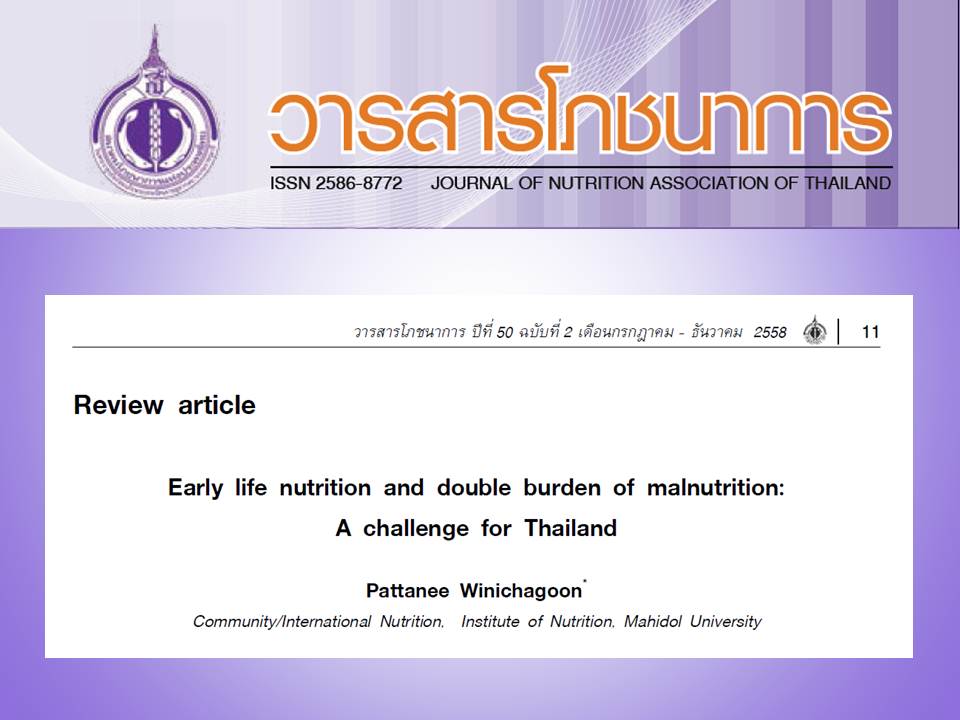Early life nutrition and double burden of malnutrition: a challenge for Thailand
Abstract
Thailand has successfully alleviated severe and moderate malnutrition in children and women during 1980s-1990s. However, the rapid national economic development has brought about the malnutrition on the other end, i.e., overnutrition, which was recognized in adults and older children. As a result, priority for control of malnutrition has been given to this diet-related chronic malnutrition. Malnutrition in young children and women received low priority due to lack of awareness of negative consequences of non-clinical malnutrition on growth and development, especially, cognition. Maternal and child nutrition integrated program becomes specific nutrition interventions addressing anemia and iodine deficiency. Moreover, as overnutrition in adults increase, it is not aware that adult women have had higher prevalence of overweight and diabetes than men, and its increaseis oversighted while it could be related to metabolic changes during pregnancy and lactation. Evidence from hospital-based data appeared to support this speculation. Early life nutrition, i.e., from conception to first 2 y of life, has received high attention in the international nutrition and global health community. Cohort studies consistently showed that malnutrition in utero is the risk of both under nutrition postnatally as well as overnutrition in later years of life if rapid weight gain associated with inappropriate feedings occurs after 3-4 y of life. Globally, prevention of maternal and young child malnutrition is placed high on the agenda, unfortunately, no specific global policy is currently advocated in Thailand.
References
2. Winichagoon P. Scaling up a community based program for maternal and child nutrition in Thailand. Food Nutr Bull. 2014;35(suppl1): 27S-33S.
3. Winichagoon P. Thailand nutrition intransition: situation and challenges of maternal and child nutrition. Asia Pac J Clin Nutr. 2013;22(1):6-15.
4. สำนักงานสถิติแห่งชาติ, กระทรวงสาธารณสุขและองค์การยูนิเซฟประเทศไทย. รายงานการสำรวจสถานการณ์เด็กและสตรีในประเทศไทย (Multiple Indicator Cluster Survey, [MICS 2012]). กรุงเทพฯ 2555.
5. พัตธนี วินิจจะกูล. บทบาทของธาตุเหล็กต่อปัญหาโลหิตจางในประเทศกำลังพัฒนา. โลหิตวิทยาและเวชศาสตร์บริการโลหิต. 2551;18(4):321-30.
6. Food and Nutrition Board, Institute of Medicine, US. Dietary reference intakesfor vitamin A, vitamin K, arsenic, boron, chromium, copper, iodine, iron, manganese, molybdenum, nickel, silicon, vanadium, andzinc. Washington, D.C.: National academy press; 2001.
7. Tuntawiroon M, Sritongkul N, Brune M, Rossander-Hulten L, Pleehachinda R, Suwanik R, Hallberg L. Dose-dependent inhibitory effect of phenolic compounds in foods on nonheme iron absorption in men. Am J Clin Nutr.1991;53:554-7.
8. วิชัย เอกพลากร. สำนักงานสำรวจสุขภาพประชาชนไทย. รายงานการสำรวจสุขภาพประชาชนไทยโดยการตรวจสุขภาพ ครั้งที่ 4 พ.ศ.2551-2. สุขภาพเด็ก. กรุงเทพมหานคร: เดอะ กราฟิโก ซิสเต็มส์; 2555.
9. สำนักโภชนาการ กรมอนามัย กระทรวงสาธารณสุข. แนวทางการดำเนินงาน การควบคุมและป้องกันโรคขาดสารไอโอดีน: ค่ามัธยฐานไอโอดีนในปัสสาวะในหญิงตั้งครรภ์จากระบบเฝ้าระวังและติดตามการขาดสารไอโอดีนในปี 2543-2557 [อินเตอร์เน็ต]. 2558 [เข้าถึงเมื่อ 1 มิถุนายน 2558]. เข้าถึงได้จาก: https://nutrition.anamai.moph.
go.th/temp/files/iodene_new_concep.pdf .
10. Gowachirapant S, Winichagoon P, Wyss L,Tong B, Baumgartner J, Zimmermann MB. Urinary iodine concentrations in pairs of pregnant women and their school-aged children from Thai households indicate iodine sufficiency in the children butiodine deficiency in the women. J Nutr. 2009;139:1169-72.
11. Winichagoon P, Udomkesmalee E. Vitamin A: discrimination and integration. World Nutrition. 2015;6(4):322-6.
12. สำนักงานสถิติแห่งชาติ กระทรวงเทคโนโลยีสารสนเทศและการสื่อสาร. ประมวลสถิติสำคัญของประเทศไทย พ.ศ.2555: ความชุกของน้ำหนักแรกเกิดสูง (>3500-5000 กรัม) ปี พ.ศ. 2548-2553 [อินเตอร์เน็ต]. 2555 [เข้าถึงเมื่อ 1 มิถุนายน 2558]. เข้าถึงได้จาก: https://service.nso.go.th/nso/nsopublish/pubs/pubsfiles/Key55_T.pdf.
13. Titapant V, Lertbunnaphong T, Pimsen S. Is the US institute of medicine recommendation for gestational weight gain suitable for Thai singleton pregnant women? J Med Assoc Thai. 2013;96(1):1-6.
14. Sunsaneevithayakul P, Titapant V, Ruangvutilert P, Sutantawibul A, Phatihattakorn C, Watanagara T, Tualngchit P. Relation between gestational weight gain and pregnancy outcomes. J Obstet Gynecol Res. 2014;40(4):995-1001.
15. Torloni MR, Betrán AP, Horta BL, Nakamura MU, Atallah AN, Moron AF, et al. Prepregnancy BMI and the risk of gestationaldiabetes: a systematic review of the literature with meta-analysis. Obes Rev. 2008;10: 194-203.
16. Chanprapaph P, Sutjarit C. Prevalence of gestational diabetes mellitus(GDM) in women screened by glucose challenge test (GCT) at Maharaj Nakorn Chiang Mai hospital. J Med Assoc Thai. 2004;87:1141-6.
17. Feig DS, Zinman B, Wang X, Hux JE. Risk of development of diabetes mellitus after diagnosis of gestational diabetes. Can Med Assoc J. 2008;179(3):229-34.
18. Cheng HR, Walker LO, Tseng YF, LinPC. Postpartum weight retention in women in Asia: a systematic review. Obes Rev. 2011;12:770-80.
19. วิชัย เอกพลากร. สำนักงานสำรวจสุขภาพประชาชนไทย. รายงานการสำรวจสุขภาพประชาชนไทยโดยการตรวจสุขภาพ ครั้งที่ 4 พ.ศ. 2551-2. การสำรวจภาวะสุขภาพของคนไทยในปี พ.ศ. 2554. กรุงเทพมหานคร: เดอะ กราฟิโก ซิสเต็มส์; 2555.
20. Koletzko B, Kries RV, Closa R, Escribano J, Scaglioni S, Giovannini M, et al. European childhood obesity trial study group. Lower protein in infant formula is associated with lower weight up to age 2 y: a randomized clinical trial. Am J Clin Nutr. 2009;89(6):1836-45.
21. Weber M, Grote V, Closa-Monasterolo R, Escribano J, Langhendries JP, Dain E, et al. European childhood obesity trial study group. Lower protein content in infantformula reduces BMI and obesity risk atschool age: follow-up of a randomized trial. Am J Clin Nutr. 2014;99:1041-51.
22. Winichagoon P. Transition of maternal and child nutrition in Asia: implications for public health. Curr Opin Clin Nutr Metab Care. 2015;18:312–7.
23. Barker DJ. The origins of the developmental origins theory. J Intern Med. 2007;261(5):412–7.
24. Hansen M, Gluckman P. Developmental origins of noncommunicable disease: population and public health implications. Am J Clin Nutr. 2011;94(suppl):1754S-8S.
25. Victora CG, Adair L, Fall C, et al. For the maternal and child undernutrition group. Maternal and child undernutrition: consequences for adult health and humancapital. Lancet. 2008;371:340–57.
26. Uauy R, Kain J, Corvalan C. How can the developmental origins of health and disease (DOHaD) hypothesis contribute to improving health in developing countries? Am J ClinNutr. 2011;4(suppl):1759S-64S.
27. Black RE, Victor CG, Walker SP, et al. Maternal and child undernutrition and overweight in low-income and middle income countries. Lancet. 2013;382:427-51.
28. De Onis M, Garza C, Onyango AW and Martorell R. WHO child growth standard. Acta Pediatrica. 2006;450(Suppl):5-101.
29. World Health Organization. Indicators for assessing infant and young childfeeding practices: conclusions of a consensus meeting held 6-8 November 2007. Washington D.C: WHO; 2008.

Downloads
Published
How to Cite
Issue
Section
License
Upon acceptance of an article, copyright is belonging to the Nutrition Association of Thailand.


